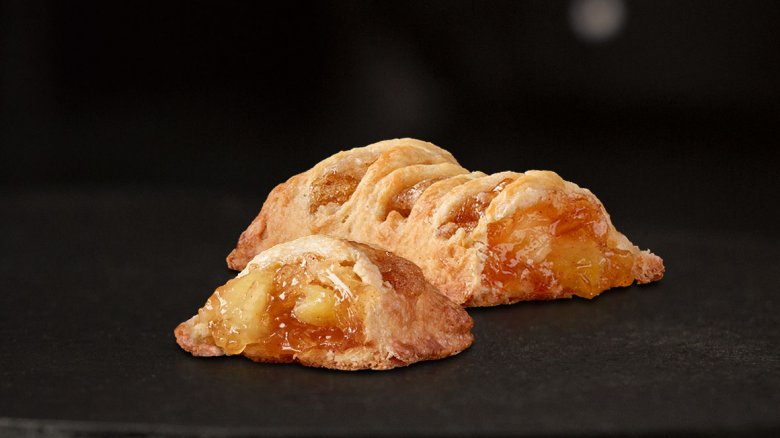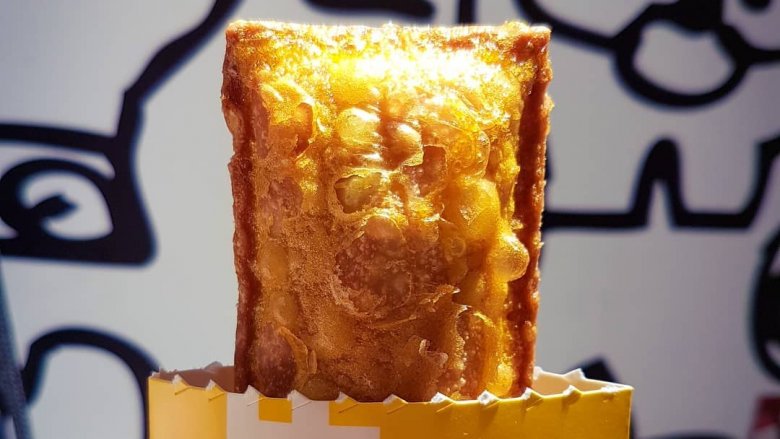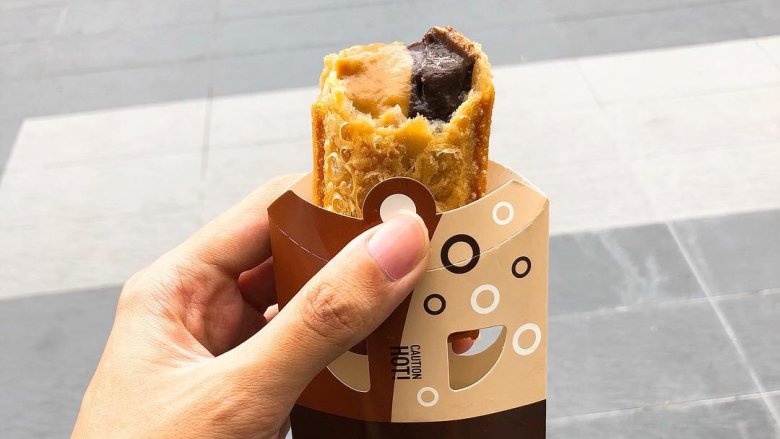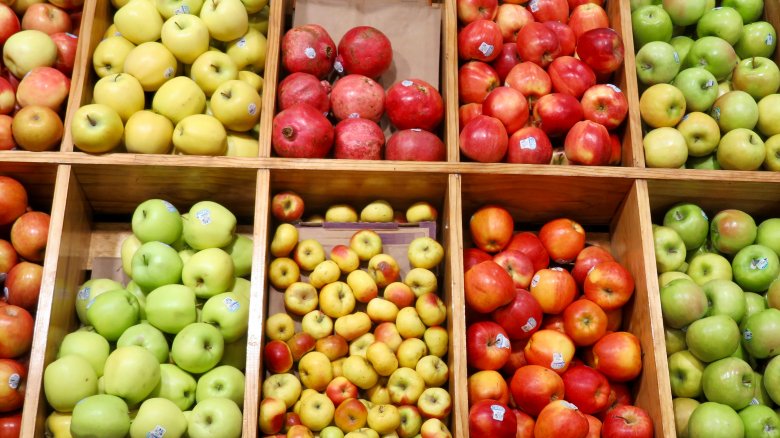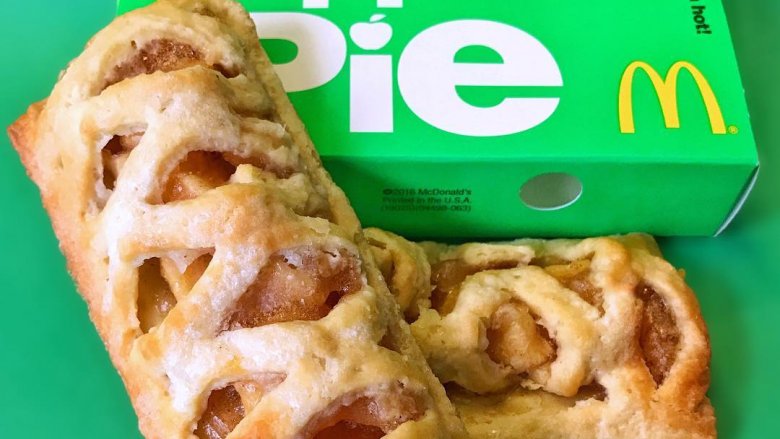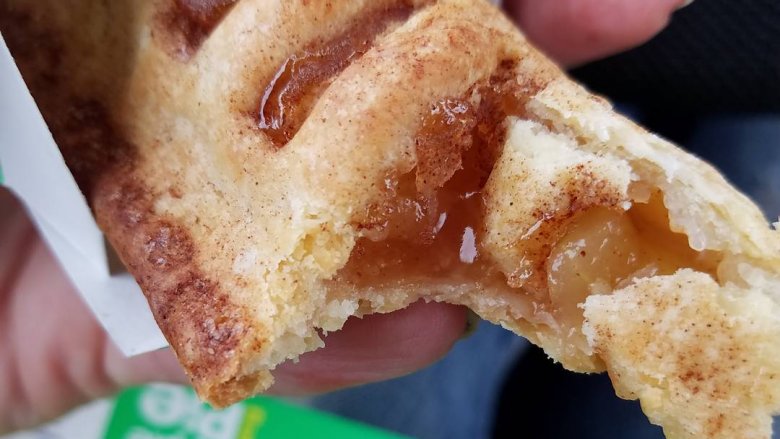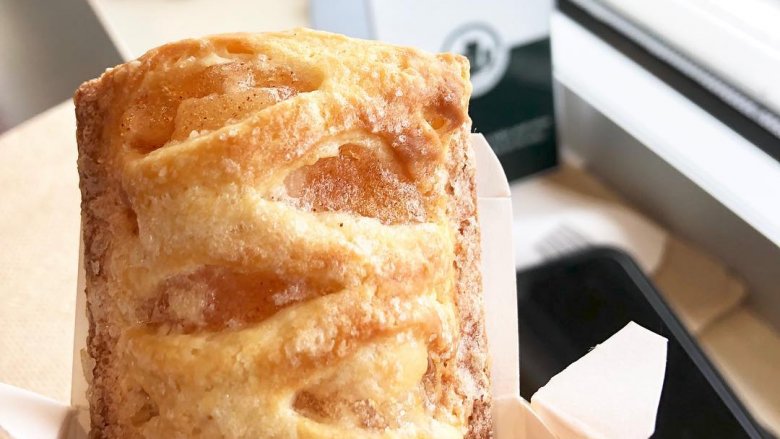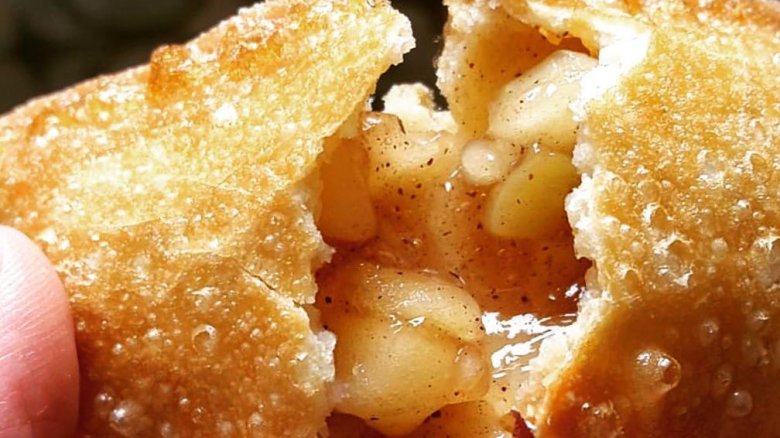This Is Why McDonald's Pies Taste Different Than They Used To
If you're over the age of 35 or so, you probably have fond childhood memories of the apple pie from McDonald's. Served at screeching hot, mouth-destroying temperatures in a grease-spattered cardboard sleeve, the apple pie in those days was enough to send our toddler-brains into something approaching chemical-induced ecstasy — a flaky, deep-fried crust, all blistered and crispy on the outside, with soft layers of pastry on the inside, surrounding a payload of hot, gooey, cinnamon-spiked apple compote. It made for the perfect end to a weeknight family meal of fast food, on those sleepy gray evenings where Mom couldn't face another night of cooking and Dad was already asleep on the couch.
If you've succumbed to a fit of nostalgia and added an apple pie to your McDonald's order in recent years, however, you may have noticed that the pies the restaurant is serving today don't quite align themselves with those fond childhood memories. It may be tough to put your finger on, but you know in your heart that something is different about those pies. Fortunately, we're here to help. Here's the rundown on what's changed about McDonald's pies, and taken them from a must-have craveable dessert to a hard post-meal pass.
They used to be deep-fried
The single biggest detrimental change to our beloved pies came one fateful day in 1992, a day that McDonald's enthusiasts still contemplate with somber reflection and hushed voices. It was the day McDonald's decision to stop cooking their signature apple pie in the deep fryers, and switch to a baked, lattice-crusted imitator that was destined to become the subject of much scorn and debate.
Why would the McDonald's corporation take a perfectly successful product, celebrated by the masses and burned into the memories of customers, and replace it with such a sad, soggy, doughy, limp pretender? Some hypothesize that the change was an attempt by McDonald's to increase the "healthy" perceptions of its product in the early 1990s, the same era that blessed consumers with the McLean Deluxe and the Chicken Fajitas. Others speculate that the ridiculously hot filling was the reason for the switch — in the fast food lawsuit landscape of the early '90s, serving apple pies with filling hotter than molten aluminum was an accident waiting to happen.
If you miss McDonald's fried pies as much as we do, there's a glimmer of good news: You can still get your dessert treat just the way you remember it, in all of its deep-fried, bubbly, slightly salty glory, and all you have to do is hop on a plane. That's because many international McDonald's locations (including the U.K., Mexico, Brazil, Greece, Ireland, Egypt, and Hong Kong) continue serving their pies the old-fashioned, deep-fried way.
Now that there are so many flavors, they don't seem as special
For decades, the dessert options at McDonald's were few: You could get a box of dusty, flavorless McDonaldland cookies, or you could (sometimes) ask for a plastic cup full of soft serve from the seemingly perpetually broken ice cream machine. The fried McDonald's pies, for years available in your choice of only apple or cherry, seemed special — toasty, crispy, hot, and utterly unique to a complete meal at McDonald's.
When the fast food chain stopped frying their pies in 1992, they tried to distract us from the fact that the new baked version was vastly inferior by introducing an avalanche of new pie flavors. In the decades that followed, McDonald's has experimented with more than 40 limited time offerings including Pumpkin, Lemon, S'mores, Strawberry & Crème, Blueberry, and the insulin-shattering "Holiday Pie," a sugary confection filled with vanilla custard, glazed with sugar, and topped with rainbow sprinkles.
Could it be that this constant rollout of new pie flavor variations somehow work together to make the original seem less...special? Pies from McDonald's are no longer this singular, perfect thing, and with competition from other desserts like sundaes, McFlurrys, cones, cookies, and donut sticks, they're pretty far down on the list of things we'll order to satisfy our sugar cravings.
The apple varieties change from time to time
In 2018, McDonald's unveiled another tweak to its iconic pie recipe, by switching up its apples as part of an overhaul of the dessert's unhealthy image. McDonald's has always used different apples for their pies depending on the time of year, but according to the company, the new pies feature "sliced, 100 percent American grown apples, including Golden Delicious, Jonagold, Rome, Gala, Ida Red, and Fuji."
We're not sure what that implies about the country of origin or variety of the apples McDonald's USED to use for their pies, but with McDonald's buying more apples than any restaurant chain in the United States, there's no question that the switch is good for American farmers, many of whom perform farm upgrades and make crop planting choices based entirely on McDonald's demands. Chances are, though, that with the dump trucks full of cinnamon and sugar used in the apple pie filling, you're probably not noticing things like subtle shifts in apple pedigree.
The recipe changed in 2018 to make the pies healthier
When McDonald's made the decision to stop frying their apple pies back in 1992, it came as a real blow to customers who prefer things that taste good, to things that are maybe only marginally healthier. But McDonald's wasn't done tweaking its pie formula yet; more changes to the signature dessert came in 2018.
The idea sounds good, at least on paper: McDonald's reformulated its 50-year-old dessert in an effort to affirm its commitment to real food with fewer ingredients and reduced preservatives. The apple pie wasn't the only recipe that changed; according to McDonald's spokesperson Tiffany Briggs, "We removed, for example, artificial preservatives from our Chicken McNuggets and switched to real butter in our breakfast sandwiches because those changes matter to our guests."
The new formula means a reduction in the overall number of preservatives and laboratory-grade additives used in the pie recipe, and though the result should be a better pie, the reactions on social media have been critical. One Twitter user summed up the situation neatly, exclaiming, "Where's the apple PIE?!! The Franken-Strudel you have offered 2 nite is yet another example of big business sticking it to the common man!"
They're no longer topped with brown sugar
Prior to 2018, the apple pie at McDonald's was covered in a light glaze made from brown sugar. In addition to contributing a lovely toasty brown color to the cooked pie, the glaze added a slight crunch and lots of lightly nutty, subtle caramel sweetness that perfectly balanced the super sweet, cinnamony apple filling.
When McDonald's reformulated its apple pies in 2018, one of the first things to go was that coveted brown sugar glaze that made the pies seem like they might have actually been baked by somebody's grandmother. McDonald's apple pies are now dusted with granulated white sugar, which tends to be overly sweet, unpleasantly gritty, and lacks the subtlety and character of the brown sugar glaze.
We're not sure why they made the switch since with the brown sugar gone it may seem like there's less sugar in the pies, but the reformulated version actually contains three more grams of overall sugar than its predecessor.
The crust is different
In addition to the other changes McDonald's foisted on the general public as part of its wholly unnecessary reformulation of its apple pie in 2018, the crust itself underwent a series of changes. The change you immediately notice when you slide one of the new pies out of its cardboard box is the criss-crossed lattice surface of the pie.
We suppose the new crust was an effort to make the pies look more homemade, or maybe to trick the public into thinking that there's less crust overall, which would potentially make the pies healthier. (It doesn't — the new pies still contain roughly the same amount of carbohydrates as the pre-2018 version.)
But the change doesn't seem limited to aesthetics. The new crust has a springier, lighter texture, more akin to a strudel dough than a traditional pie crust, and a far cry from the crackly, puffy, blistered perfection that encrusted the fried apple pies back in the 1980s. Though we can't pin down exactly what recipes changes the crust underwent, it definitely doesn't taste the same.
As usual, the response on Twitter to the change was measured and restrained, and by that we mean it was totally unhinged and hysterical. "If you're going to change the recipe for the apple pie, fine," said one user, "BUT YOU MESSED WITH THE CRUST. No, no no. Where's the crust? There's more holes than crust in this so-called 'crust'. I want my old pie back."
The apples are cut differently
The changes to the apple pies McDonald's introduced in 2018 were part of a reconsideration of every part of the pies' formula, right down to the way in which the apples in the sweet filling were cut. Prior to 2018, McDonald's used apples chopped into a fine dice, which made for a filling that was only sorta chunky and a whole lotta mushy.
The new version of the pie uses sliced apples, and the feedback so far hasn't been favorable. According to The Takeout, the filling "lacked the gooey, gelatinous texture of our youth. Nobody could really decide whether that was a good or a bad thing, but this new pie lacks that comforting nostalgia factor. This filling is crunchier, highlighting the variety of apples McDonald's is crowing about, like Golden Delicious, Jonagold, Rome, Gala, Ida Red, and Fuji. So the fruit had a nice chunky bite to it, not mushy. But the overall effect was a bit underwhelming."
